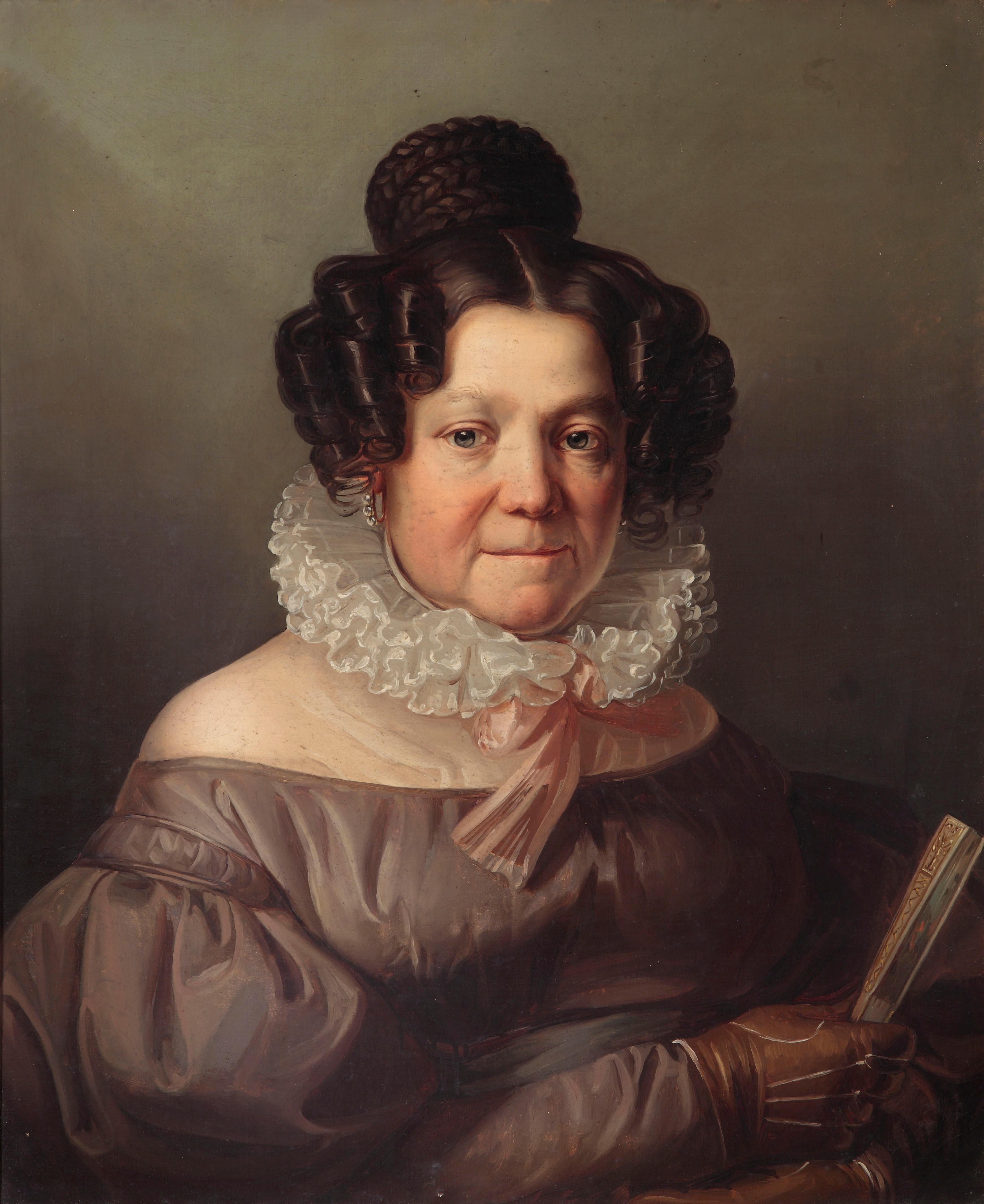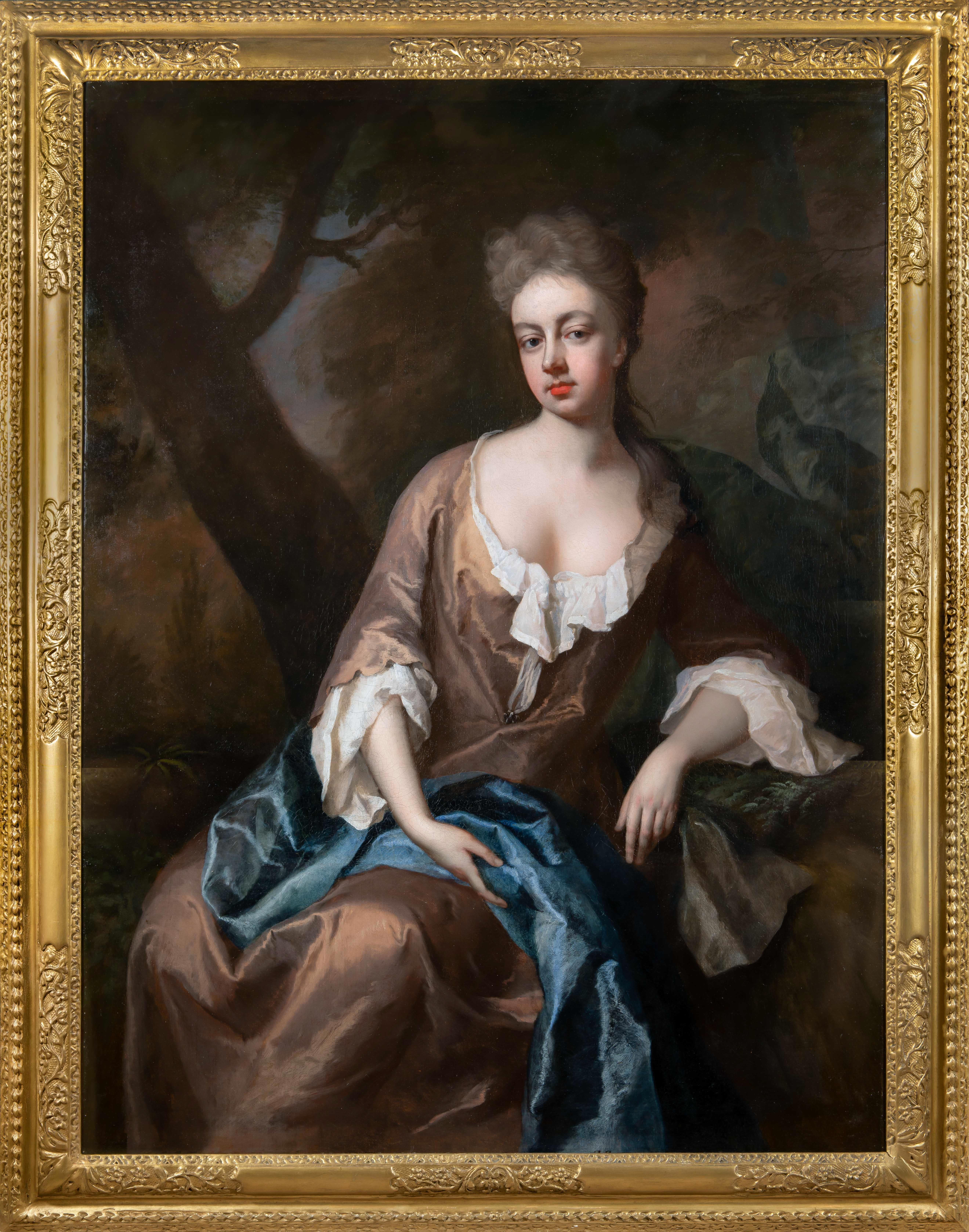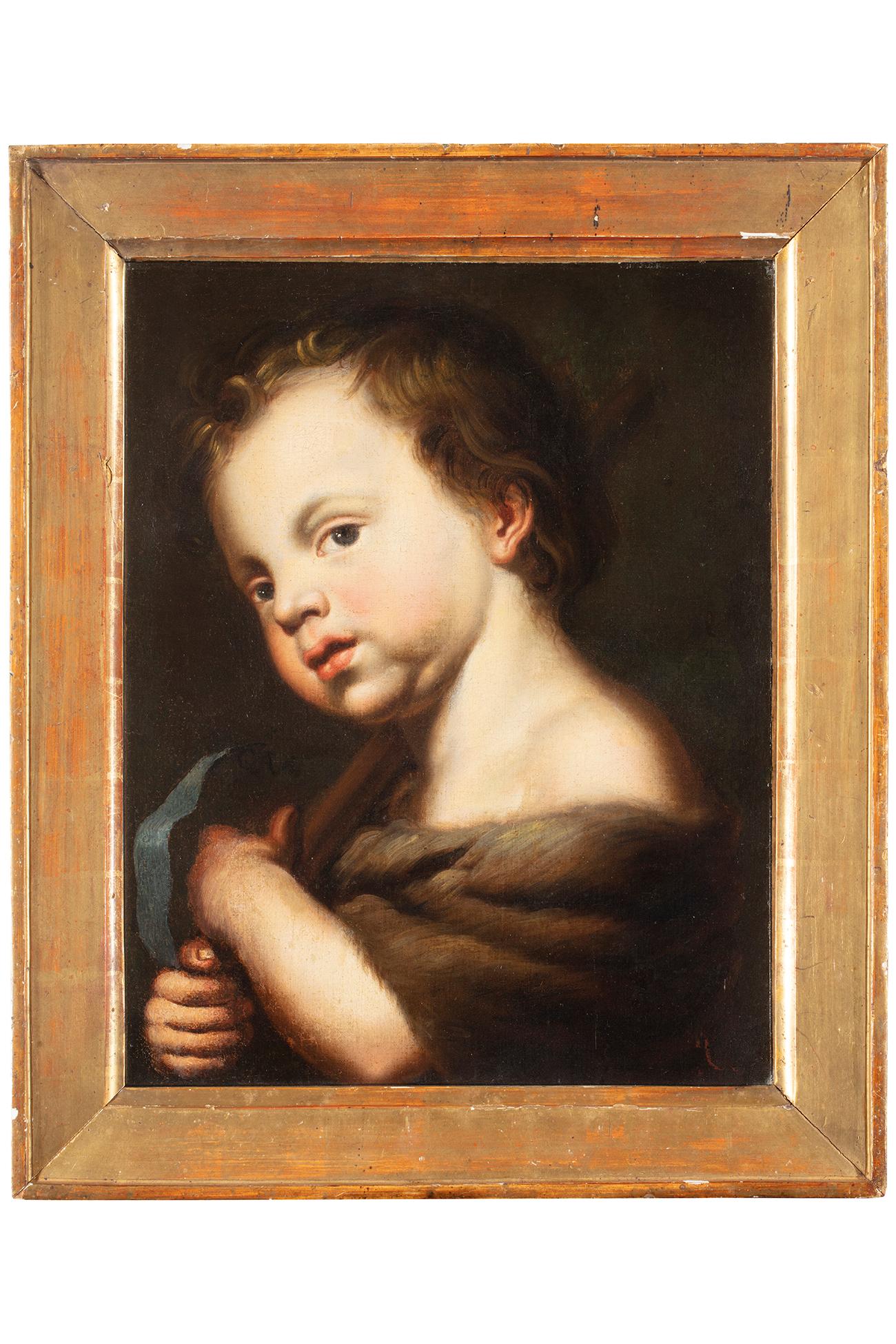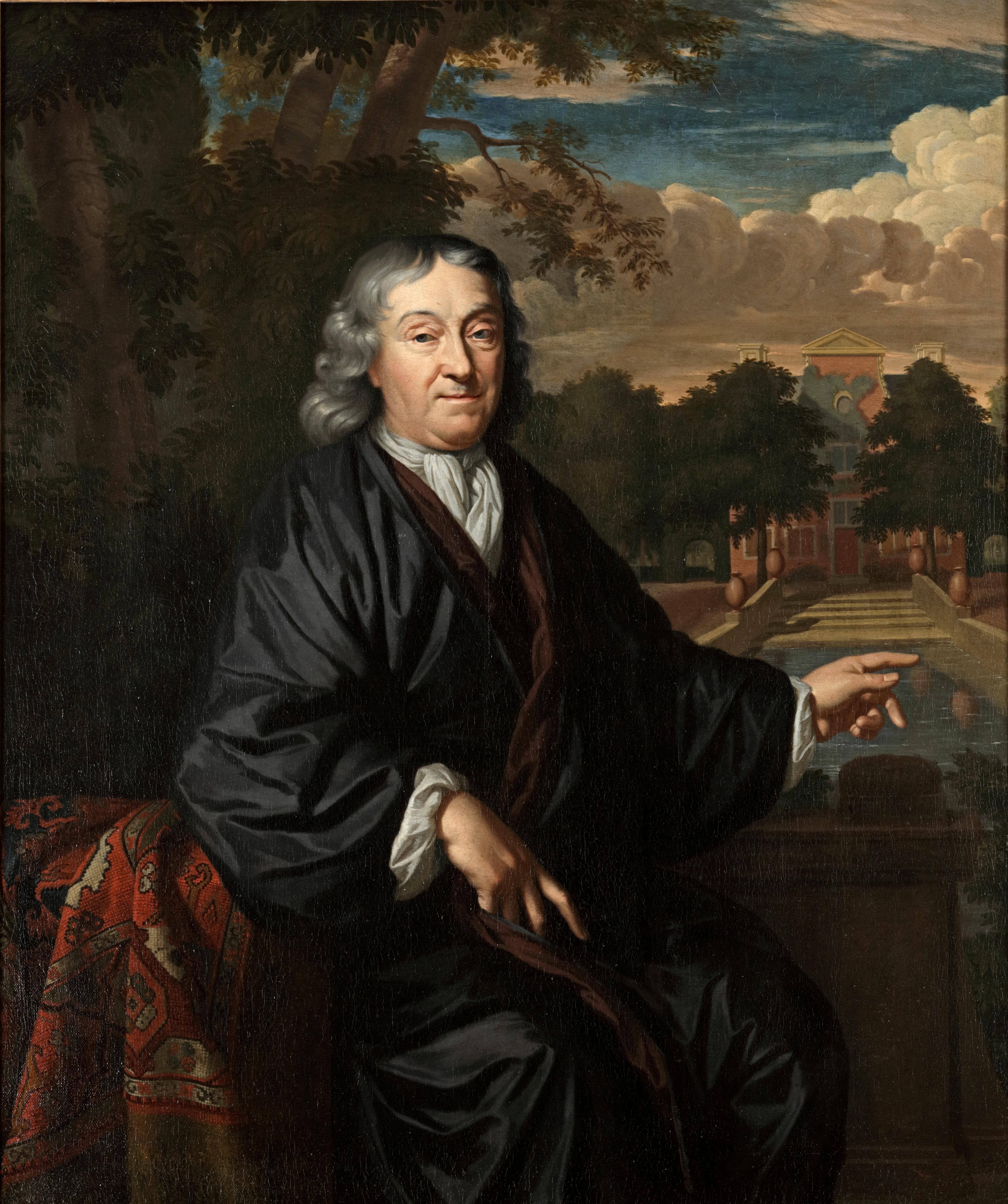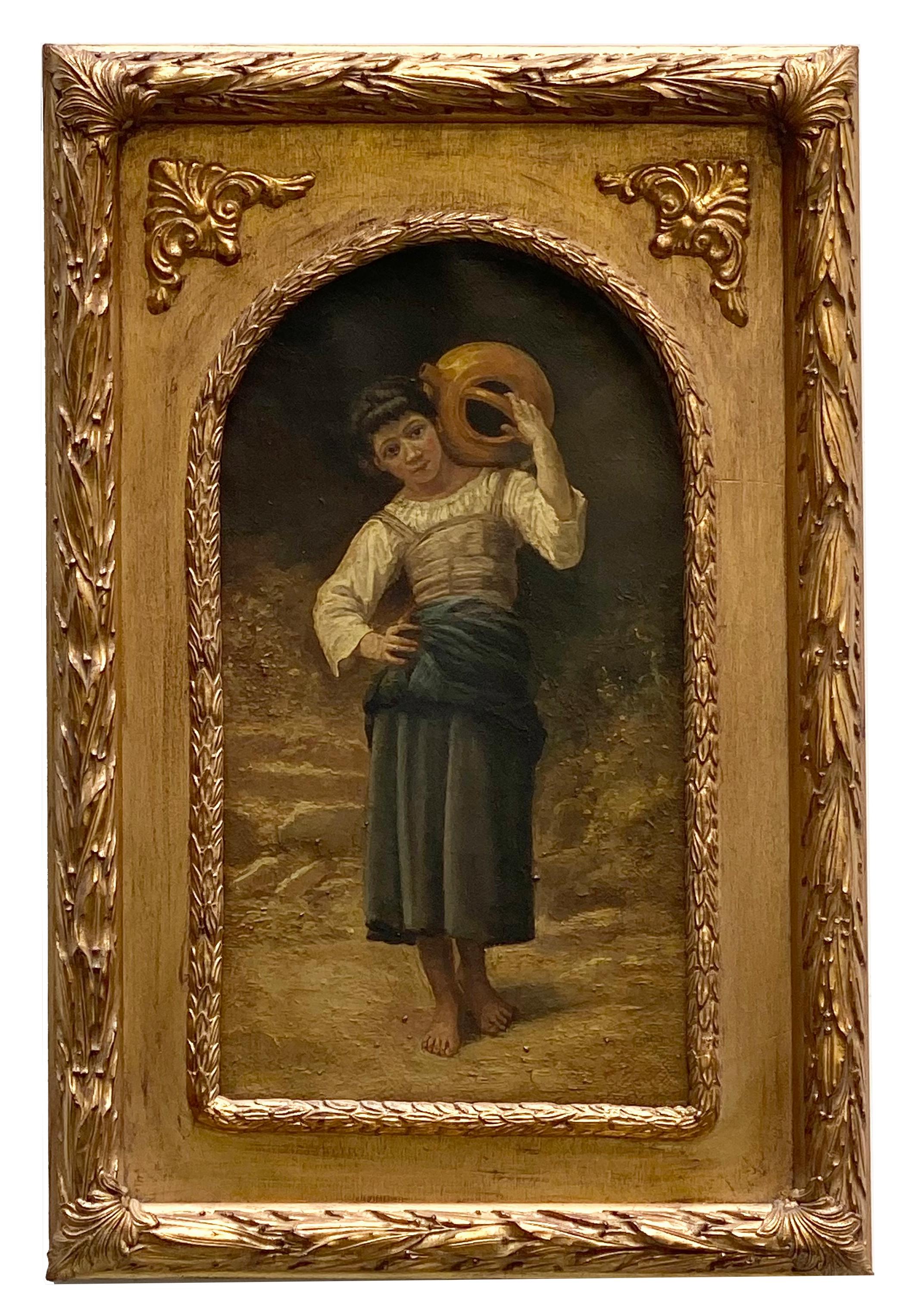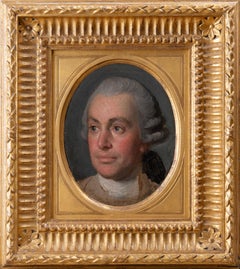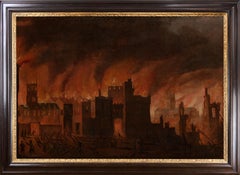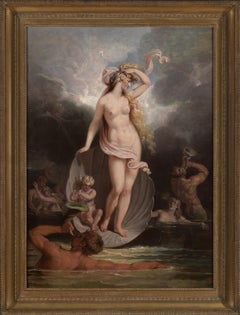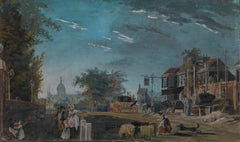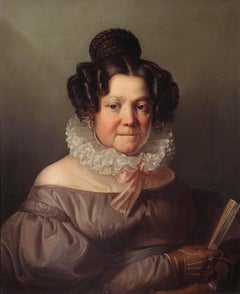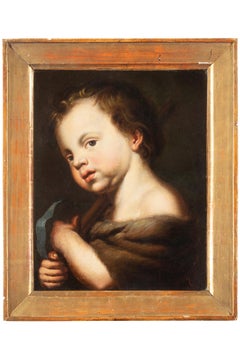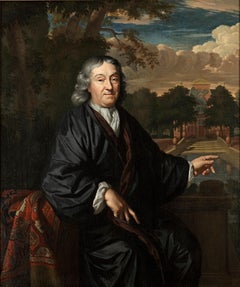Items Similar to 19th century portrait painted in St Petersburg in 1819
Want more images or videos?
Request additional images or videos from the seller
1 of 8
George Dawe19th century portrait painted in St Petersburg in 18191819
1819
About the Item
Signed, inscribed and dated, lower right:
'Geo Dawe RA St Petersburgh 1819', also signed
with initials, lower centre: 'G D RA'; and signed and inscribed verso:
'Geo Dawe RA Pinxit 1819 St Petersburgh';
Also inscribed on the stretcher by Cornelius Varley with varnishing instructions.
Collections:
Private collection, UK, 2010
Literature:
Galina Andreeva Geniuses of War, Weal and Beauty: George Dawe RA,
Moscow, 2012, illustrated p.122.
This remarkably vivacious portrait was executed very soon after Dawe’s arrival in St Petersburg where he was to fulfil a commission from Alexander I, Emperor of Russia, to paint the heroes of the 1812 campaign. This commission was to occupy Dawe for the rest of his career and resulted in a gallery of over three hundred portraits for the Military Gallery of the Winter Palace (Hermitage Museum, St Petersburg). This, as yet, unidentified portrait, appears to have returned home with Dawe at the end of stay in Russia and may well be a record of an early friendship made in St Petersburg’s artistic or literary circles.
Dawe is now the least celebrated of the major late Georgian portrait painters in spite of being compared in his lifetime with both Thomas Lawrence and Jacques-Louis David. Undoubtedly, his removal from London at a vital period of his career left the field entirely clear for Lawrence, whose only clear rival he was. Dawe certainly made a rapid impression in Russia with Pushkin dedicating the following verse to him:
'Why does your wondrous pencil strive
My Moorish profile to elicit?
Your art will help it to survive,
But Mephistopheles will hiss it.
Draw Miss Olenin's face. To serve
His blazing inspiration's duty,
The genius should spend his verve
On homage but to youth and beauty.'
George Dawe was the son of Philip Dawe a well-known engraver, and named after his godfather, the painter, George Morland. His younger siblings, Henry, James and Mary all followed artistic careers. George trained as an engraver and in 1794 entered the Royal Academy Schools and in 1803 received the gold medal for Achilles, Frantic for the Loss of Patroclus, Rejecting the Consolation of Thetis (Museum of New Zealand Te Papa Tongarewa, Wellington), which was regarded by contemporaries as ‘the best ever offered to the Academy on a similar occasion’. He first exhibited at the Royal Academy in 1804 and the rise of this talented painter through the hierarchy was rapid, being elected an Associate in 1809 and an Academician in 1814. Dawe continued to exhibit portraits but mostly subject pictures up until his the time of his elevation at the Academy and thereafter showed only portraits having secured his reputation as a painter.
Dawe established a respectable practise as a portrait painter from about 1806 and in 1809 exhibited his full-length portrait of Mrs White, one of the most remarkable portraits of the period. By 1811 he was receiving the patronage of the banker, Thomas Hope, one of the principal connoisseurs and arbiters of taste of the day and Dawe’s success was assured. In the summer of 1815 Dawe briefly employed John Constable, with whom he had been acquainted since 1806, to paint in the background for the full-length portrait of the actress Eliza O'Neill as Juliet: this theatrical scene, full of romantic atmosphere achieved by the effect of glittering lamplight, stirred public opinion when exhibited both in London at the Royal Academy in 1816 and later in St Petersburg in 1827.
Dawe seems to have established himself in the unofficial rôle of a Court Painter with commissions of portraits of Princess Charlotte and Prince Leopold of Saxe Coburg Saalfeld, later king of the Belgians, who married in 1816 and the Duke and Duchess of Kent. Under the patronage of the Duke of Kent, Dawe travelled as part of his retinue, visiting Paris, Cambrai, Brussels, and Aix-la-Chapelle for the Congress between Britain, Austria, Prussia and Russia. In the autumn of 1818 while working at Aix on a portrait of Prince Volkonsky, Dawe was noticed by Emperor Alexander I and invited to go to St Petersburg to paint, on very profitable terms, more than three hundred portraits of Russian commanders who had distinguished themselves in the campaign against Napoleon.
Dawe travelled to the Russian capital via Germany, where in Weimar he met and painted Goethe (Goethe Museum, Weimar) and discussed with him his essay on the theory of colour then in preparation. Dawe arrived in St Petersburg in the spring of 1819 and established his studio there for ten years until May 1828, although he briefly returned in the spring of 1829. For five years, until the Military Gallery opened in the Winter Palace in December 1826, Dawe's studio included his brother Henry and brother-in-law Thomas Wright (who married Mary Margaret Dawe in St Petersburg in 1825). Dr Galina Andreeva numbers about four hundred military and not less than a hundred society portraits by Dawe whilst he was working in Russia. Among the best portraits painted by Dawe in Russia are those of Barclay de Tolly and Admiral Shishkov (both in the State Hermitage Museum, St Petersburg); the young Countess Stroganov (Alupka Palace, Alupka, Crimea), and the Mezhakov family (Vologda Art Gallery, Vologda).
In spite of his prodigious output, Dawe was also known for his diverse interests, finding time to study anatomy, the theory of colour, psychology, and languages including Russian which he attempted to use on his extensive travels in Russia. He also built up a fine collection of old masters many of which were sold after his death in London.
Dawe enjoyed an unparalleled success in Russia: in 1820 Dawe was elected an honorary member of the Academy of Fine Arts in St Petersburg, where in 1827 he was allowed to exhibit 150 portraits. In the winter of 1826 he held a solo exhibition in Moscow and on the death of Dawe’s patron, the new Emperor, Nicholas I, chose him as Court Painter for the coronation ceremony. The following year he was appointed the First Portrait Painter at court and in 1829 accompanied Grand Duke Constantine to Warsaw.
On his first return to England, Dawe brought with him several Russian portraits and in November 1828 showed them to King William IV at Windsor Castle, before departing again for Russia. During his journey, which took from November 1828 to February 1829, Dawe visited the courts of Germany and France where he was enthusiastically received. Dawe’s stay in St Petersburg was, however, short-lived as he had been suffering from ill health for some time and in August 1829 returned permanently to London. Dawe died a few months later and on 27 October he was buried with honours in St Paul's Cathedral.
- Creator:George Dawe (1781 - 1829, English)
- Creation Year:1819
- Dimensions:Height: 26 in (66.04 cm)Width: 22.5 in (57.15 cm)
- Medium:
- Movement & Style:
- Period:
- Condition:In excellent condition, the canvas is unlined. In a fine gilt-wood frame.
- Gallery Location:London, GB
- Reference Number:1stDibs: LU150727720142
About the Seller
5.0
Recognized Seller
These prestigious sellers are industry leaders and represent the highest echelon for item quality and design.
1stDibs seller since 2021
- ShippingRetrieving quote...Shipping from: London, United Kingdom
- Return Policy
Authenticity Guarantee
In the unlikely event there’s an issue with an item’s authenticity, contact us within 1 year for a full refund. DetailsMoney-Back Guarantee
If your item is not as described, is damaged in transit, or does not arrive, contact us within 7 days for a full refund. Details24-Hour Cancellation
You have a 24-hour grace period in which to reconsider your purchase, with no questions asked.Vetted Professional Sellers
Our world-class sellers must adhere to strict standards for service and quality, maintaining the integrity of our listings.Price-Match Guarantee
If you find that a seller listed the same item for a lower price elsewhere, we’ll match it.Trusted Global Delivery
Our best-in-class carrier network provides specialized shipping options worldwide, including custom delivery.More From This Seller
View All18th century portrait of the painter Nathaniel Dance
Located in London, GB
Collections:
Robert Gallon (1845-1925);
Private Collection, UK.
Oil on canvas laid down on panel
Framed dimensions: 11.5 x 10 inches
This highly engaging, previously unpublished portrait by Johan...
Category
18th Century Old Masters Portrait Paintings
Materials
Canvas, Oil, Wood Panel
Early oil depicting the Great Fire of London
Located in London, GB
The Great Fire of London in September 1666 was one of the greatest disasters in the city’s history. The City, with its wooden houses crowded together in narrow streets, was a natural fire risk, and predictions that London would burn down became a shocking reality. The fire began in a bakery in Pudding Lane, an area near the Thames teeming with warehouses and shops full of flammable materials, such as timber, oil, coal, pitch and turpentine. Inevitably the fire spread rapidly from this area into the City. Our painting depicts the impact of the fire on those who were caught in it and creates a very dramatic impression of what the fire was like. Closer inspection reveals a scene of chaos and panic with people running out of the gates. It shows Cripplegate in the north of the City, with St Giles without Cripplegate to its left, in flames (on the site of the present day Barbican). The painting probably represents the fire on the night of Tuesday 4 September, when four-fifths of the City was burning at once, including St Paul's Cathedral. Old St Paul’s can be seen to the right of the canvas, the medieval church with its thick stone walls, was considered a place of safety, but the building was covered in wooden scaffolding as it was in the midst of being restored by the then little known architect, Christopher Wren and caught fire. Our painting seems to depict a specific moment on the Tuesday night when the lead on St Paul’s caught fire and, as the diarist John Evelyn described: ‘the stones of Paul’s flew like grenades, the melting lead running down the streets in a stream and the very pavements glowing with the firey redness, so as no horse, nor man, was able to tread on them.’
Although the loss of life was minimal, some accounts record only sixteen perished, the magnitude of the property loss was shocking – some four hundred and thirty acres, about eighty per cent of the City proper was destroyed, including over thirteen thousand houses, eighty-nine churches, and fifty-two Guild Halls. Thousands were homeless and financially ruined. The Great Fire, and the subsequent fire of 1676, which destroyed over six hundred houses south of the Thames, changed the appearance of London forever. The one constructive outcome of the Great Fire was that the plague, which had devastated the population of London since 1665, diminished greatly, due to the mass death of the plague-carrying rats in the blaze.
The fire was widely reported in eyewitness accounts, newspapers, letters and diaries. Samuel Pepys recorded climbing the steeple of Barking Church from which he viewed the destroyed City: ‘the saddest sight of desolation that I ever saw.’ There was an official enquiry into the causes of the fire, petitions to the King and Lord Mayor to rebuild, new legislation and building Acts. Naturally, the fire became a dramatic and extremely popular subject for painters and engravers. A group of works relatively closely related to the present picture have been traditionally ascribed to Jan Griffier...
Category
17th Century Old Masters Landscape Paintings
Materials
Oil, Canvas
18th century allegorical painting of The Triumph of Beauty
Located in London, GB
Exhibited:
London, Royal Academy, 1800, no. 93
What was happening in British history painting in around 1800? In recent discussions of the emergence of a British School of history painting following the foundation of the Royal Academy in 1768, this is a question which is rarely posed and one which is not easily answered. Examination of surviving Royal Academy exhibition catalogues reveals a profusion of artists’ names and titles, few of which remain immediately recognizable, whilst endeavours to explain the impact of exhibition culture on painting - such as the 2001 Courtauld show Art on the Line - have tended to focus on the first and second generation of Royal Academician, rather than young or aspiring artists in the early nineteenth century. This makes the discovery and identification of the work under discussion of exceptional importance in making sense of currents in English painting around 1800. Executed by Edward Dayes...
Category
18th Century Old Masters Figurative Paintings
Materials
Canvas, Oil
18th century view of the Elephant and Castle in London
Located in London, GB
Collections:
With Martyn Gregory;
Judy Egerton, 1984, acquired from the above;
By descent to 2014.
Exhibited:
London, Martyn Gregory, Exhibition of English & Continental Watercolours, 1984, no. 94.
London, Lowell Libson...
Category
18th Century Old Masters Landscape Paintings
Materials
Gouache, Vellum
19th century watercolour of a Girl at her Dressing Table
By William Henry Hunt
Located in London, GB
Collections:
Muir Hetherington;
Sir John and Lady Witt, acquired 1974;
By descent to 2015.
Literature:
Tom Jones (ed.), William Henry Hunt 1790-1864, exh. cat., 1981, no. 145 (Girl in a bedroom);
John Witt, William Henry Hunt (1790-1864) Life and Work, London, 1982, no. 553, p. 194, colour pl. 16.
Exhibited:
Wolverhampton, Central Art Gallery, Preston, Harris Museum and Art Gallery and Hastings, Hastings Museum and Art Gallery, William Henry Hunt 1790-1864, 1981, no. 145 as Girl in a bedroom (Lent by Sir John & Lady Witt)
Framed dimensions: 20 x 20.75 inches
This unusually charming and well-preserved watercolour was painted by William Henry Hunt in around 1833. Almost certainly depicting his young wife, Sarah, possibly in the interior of her family home at Bramley in Hampshire. This work shows Hunt’s remarkable virtuosity as a watercolourist, Hunt, for example, articulates the profile of his young wife, by leaving a reserve of white paper to suggest the light modelling her features. Throughout the 1830s Hunt made a sequence of richly painted interior views of both domestic and agricultural spaces which pay scrupulous attention to detail.
Hunt was born in London, the son of a tin-plate worker and japanner. J. L. Roget recorded the observation of Hunt’s uncle: ‘nervy, little Billy Hunt… was always a poor cripple, and as he was fit for nothing, they made an artist of him.’ At the age of sixteen he was apprenticed to the landscape painter John Varley for seven years, moving to live with Varley at 18 Broad Street, Golden Square, London. There he made close friends with both John Linnell and William Mulready. Hunt worked at the ‘Monro Academy’, at 8 Adelphi Terrace, London, the house of Dr Thomas Monro, an enthusiastic patron of landscape watercolourists. Through Monro, Hunt was introduced to the 5th Earl of Essex...
Category
19th Century Old Masters Figurative Drawings and Watercolors
Materials
Watercolor, Pencil
18th century pastel portrait of Lady Augusta Corbett and her son, Stuart
By Daniel Gardner
Located in London, GB
Collections:
Commissioned by Andrew Corbett, husband of the sitter;
The Venerable Stuart Corbett;
Sir Stuart Corbett;
By descent to 2002;
Sotheby’s, London 21 March 2002, lot.104;
Lowell Libson...
Category
18th Century Old Masters Portrait Drawings and Watercolors
Materials
Pastel, Gouache
You May Also Like
19th Century By Giuseppe Molteni Portrait of a Woman Oil on Canvas
Located in Milano, Lombardia
Giuseppe Molteni (Affori (Milano), Italy, 1800 - Milano, Italy, 1867)
Title: Portrait of a Woman
Medium: Oil on canvas
Dimensions: without frame 67 × 55 cm - with frame 91.5 x 80 cm
...
Category
19th Century Old Masters Portrait Paintings
Materials
Canvas, Oil
Portrait of Lady Catherine Edwin (Montagu) in a Woodland c.1697; Fine Provenance
By Michael Dahl
Located in London, GB
This exquisite portrait, presented by Titan Fine Art, is by Michael Dahl; it was part of the extensive collection owned by Thomas Wyndham of Clearwell Court in Gloucestershire. It ma...
Category
17th Century Old Masters Portrait Paintings
Materials
Canvas, Oil
17th Century by Pedro Nunez Portrait of a Child Oil on Canvas
Located in Milano, Lombardia
Pedro Nuñez de Villavicendio (Seville, Spain, 1644 - 1700)
Title: Portrait of a child
Medium: Oil on canvas
Dimensions: without frame 41.5 x 33.5 cm - with frame 52 x 43.5 cm
19th century shaped and gilded wooden frame
Expertise by Didier Bodart, art historian
A Seville painter of noble origins, Pedro Nuñez de Villavicendio (1644-1700), the author of this pretty child portrait, was a Knight of the Order of St John of Jerusalem. He was a pupil of Murillo and, as a Knight of the Order of Malta, worked with Mattia Preti...
Category
Late 17th Century Old Masters Portrait Paintings
Materials
Canvas, Cotton Canvas, Oil
Male and female portrait, both in silk kimono, possibly textile dealers
By Christoffel Lubieniecki
Located in Amsterdam, NL
CHRISTOFFEL LUBIENIECKI (1659-1729)
Pair of portraits of a gentleman and a lady, both in silk kimono, before a country house (circa 1680)
Indistinctly signed “C.......” on a box under the man’s left hand
Oil on canvas, 79.5 x 67 cm each
Both sitters are portrayed wearing a silk “Japanese” coat. During the second half of the seventeenth the Japanese silk coat, an adapted Japanese kimono, became a real vogue in the Dutch elite. The exclusive Dutch trade contacts with Japan can explain the popularity of the kimono-style silk coats in the Netherlands. Everybody who could afford one, dressed in such a fashionable and comfortable coat and, like the present sitters, some proud owners had themselves portrayed in a “Japanese” coat often together with an oriental carpet to underline their standing and international connections. These portraits are the work of the Polish-born portraitist Christoffel Lubieniecki (also known as Lubienitski, Lubinitski or Lubiniecki)
Lubieniecki was first trained in Hamburg under Julian Stuhr and after 1675 in Amsterdam under Adriaen Backer and Gerard de Lairesse. He specialized in landscapes, generally of an Italianate character, and in portraits. The loving execution of these contented burghers, enjoying the garden vistas of their country house, places him alongside Amsterdam portraitists such as Constantijn Netscher and Michiel van Musscher...
Category
1680s Old Masters Portrait Paintings
Materials
Canvas, Oil
GIRL WITH KITTEN- In the Manner of F.Ballavoine's - Italy Oil on canvas paint
By Giulio Di Sotto
Located in Napoli, IT
Girl with kitten - Giulio Di Sotto Italia 2008 - Oil on canvas cm. 60x50
Frame available on request from our workshop.
This painting is Giulio Di Sotto’s personal reinterpretation of the 19th century French painter Jules Frédéric Ballavoine...
Category
Early 2000s Old Masters Portrait Paintings
Materials
Canvas, Oil
COUNTRY GIRL- W.A.Bouguereau- Italian Portarit of young peasant Oil on canvas
By Pietro Colonna
Located in Napoli, IT
Country girl - Pietro Colonna Italia 2006 - Oil on canvas cm. 45x25
Gold gilded wooden frame available on request
The painting by Pietro Colonna is a free interpretation of the paint...
Category
Early 2000s Old Masters Portrait Paintings
Materials
Canvas, Oil
Recently Viewed
View AllMore Ways To Browse
Old England Paris
Antique St Petersburg Russia
Austrian 19th Century Painting
Portrait Of Napoleon
Antique Georgian Portrait
19th Century Oil Paintings Napoleon
19th Century Military Oil Paintings
Emperor Of Russia
George Iv Painting
Anatomy Old Master
Cornelius Brown
Coronation Painting
Antique St Nicholas
Emperor Profile
War 1812
War Of 1812
G Engraved Initial
Duke And Duchess Of Windsor
